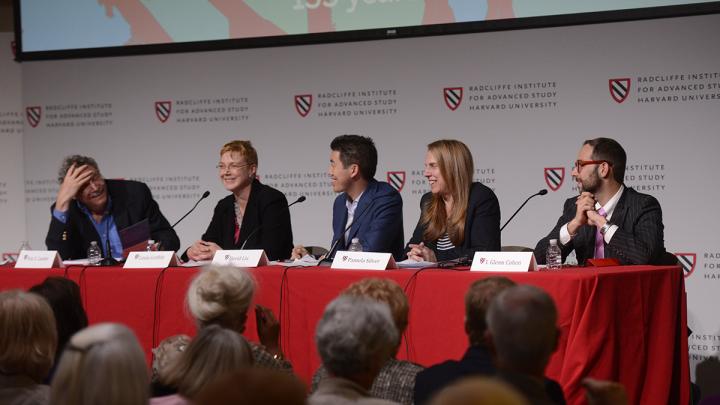In 1944, Nobel Prize-winning physicist Erwin Schrödinger catalyzed a new way of thinking about the chemical and physical origins of biology with the publication of his book What Is Life? Last Friday, Schrödinger’s question and 70 years’ worth of scientific answers reverberated throughout a discussion of “What Is Life? The Science and Ethics of Creating New Life in the Laboratory”—the last of three panels convened for Radcliffe Day 2014, May 30, to celebrate the fifteenth anniversary of the Radcliffe Institute for Advanced Study.
“The thing that life does that is most remarkable is it faithfully reproduces itself. As they say, ‘Plant a radish, get a radish, not a Brussels sprout,’” said moderator Eric S. Lander, president and founder of the Broad Institute, quoting the musical The Fantasticks. “Why is it? What is it about life?” Schrödinger posited that an “aperiodic crystal” carried the genetic information that enabled such accurate replication. Less than a decade later, that irregular, repeating molecule was found to be DNA.
“I believe that the engineering of life is the technology of this century,” declared panelist Pam Silver, RI ’12, Adams professor of biochemistry and systems biology at Harvard Medical School (see her essay "Biology in This Century" and the article "Seeing Biological Systems Whole," on the systems biology department). The past half-century of scientific advances have made it easier not only to read but also write the genetic code, she said. Her lab has engineered cells that can remember if they have been exposed to radiation, for instance, as well as bacteria that live in a mouse’s gut and signal whether the mouse has been exposed to a certain drug. “Our vision,” she said, “is that a student will be able to sit at a computer and design a cell that does a specific function.”
Moreover, new technologies are opening new avenues for medical treatments. “Virtually all methods to address human disease address symptoms—maybe the leaves of the tree or the bark of the tree,” said panelist David R. Liu ’94, professor of chemistry and chemical biology. “There have been very few therapies that address [genetic] diseases…at the level of our roots.” But now, major recent advances in genome engineering allow scientists to edit DNA with unprecedented precision, Liu explained, and gene therapy, after encountering setbacks in the 2000s, may soon become a viable treatment option. Yet the potential to change a person’s DNA is fraught with ethical dilemmas and safety concerns, panelists acknowledged. As Lander quipped, “Imagine the product recall!”
Safety aside, panelist I. Glenn Cohen, J.D. ’03, RI ’13, professor of law, summarized several frequently cited objections to the notion of improving human beings—issues of access, for instance, or deeply held notions about human nature. Panelist Linda Griffith, RI ’11, professor of biological and mechanical engineering at MIT, nonetheless noted contradictions in the popular notions of what is “natural” versus “artificial,” citing alterations such as pierced ears, dyed hair, and breast implants. “Where do we draw the line?” she asked. “Arguably, these are things that, by some definition, are viewed as enhancements already, though they’re not genetic. Where is that boundary?”
Silver agreed. “There are certain, trivial examples where we have altered the human race,” she argued. “There were certain cultures where people were thought to be short, and then it just turned out that there was a vitamin D deficiency. They’re not short anymore.” She also pointed to shifts in agriculture. “What’s normal in a plant? Corn used to look a lot different. We’re constantly changing nature—perhaps not always for the better, but most of us are trying.” She ended her comment by citing a motto of her field: “Engineering biology for the good of the world.”








